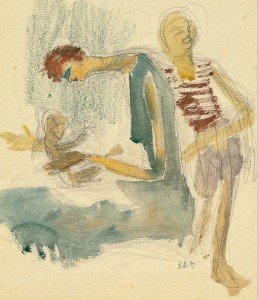Arriving on the heels of futurism, expressionism was regarded in Russia as a marginal and acratic art form that opposed and challenged the establishment. The term “futurism” itself was in Russia a rather arbitrary designation of everything new in art, and from the point of view that this phenomenon belonged to a common European culture, “futurism” was everything that could be called “art after Nietzsche”, or art of the European era of nihilism. When the place occupied by “futurism” in Russian culture became too filled up with history, it no longer held any promise for further development. A new scene, an empty space, was necessary. We see that in Russia expressionism intended to fill this empty space. But this intention never materialized, for the common cultural space was shattered and a completely different history began.
Among the literary societies of Russia during the first few years following the Communist revolution was an association of expressionist poets, formed in 1919 around the figure of Ippolit Sokolov. [13] Boris Zemenkov was one of the members of this group. However, expressionism was never validated as an emblem or platform for unifying the artistic community in 20th century Russian art. Thus, expressionism went underground and became a means of leaving the boundaries of society, setting oneself off against its norms, and defining the area of conflict.
Expressionism was present in many schools and directions of art as an attitude towards the art’s texts and tones. Moreover, expressionism allowed many different artists and beholders to dissociate themselves from a “dispensatory” model of culture that ascribed to it the right of permitting or regulating behavior. Thus, expressionism gave voice to the logic of modernity; it did not unite art on a single platform, but rather disengaged its idioms from one another, even to the point of implementing the utopian ideal of giving each artist his own idiolect.
Expressionism was a means for art to exist in the 20th century.
It was both the strategy and the innermost mythology of modernism.
It was a conception of art that went against the main intention of the establishment, which was to create and control a common cultural space by being both author and censor of the texts published within it. During the course of the 1920s, the artists of the New Society of Painters, the Masters of Analytic Art, and the Society of Painters and Sculptors made efforts to integrate the idiom of art (containing a healthy dose of expressionism) into the official program of depicting the new Soviet reality. However, the government slowly but surely refused this offer, regarding such art as inherently hostile, which it probably was.



